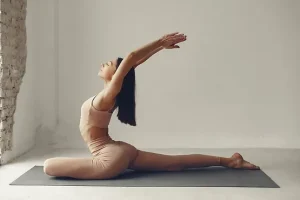Yoga is a relaxing form of exercise that offers both mental clarity and emotional balance, helping cancer patients connect with their bodies through mindfulness in a way that reduces stress. By emphasizing feelings over thoughts, this form of exercise provides cancer patients with an effective means of relieving stress.
Use these six yoga poses to relieve tension and find calm in your life.
Cat Pose
This yoga posture employs coordinated movements that work in unison to release stress, relax the neck, back and shoulders and improve posture and balance.
From a neutral tabletop position, take several slow and deliberate breaths while arching your spine as you look up. Exhale as you round back out and lower your head back down towards your chest; repeat four to eight times moving slowly and mindfully.
This gentle movement helps alleviate stress, fatigue, and mild depression by channeling energy through the Sacral Chakra. Furthermore, it stimulates and strengthens abdominal organs, improves posture, promotes spinal flexibility, and stimulates abdominal organs.
Child’s Pose with Arm Variation
Child’s Pose is an restorative pose designed to stretch and relax both your back and hips while encouraging deeper breathing.
Yoga teachers looking to take advantage of its many benefits can modify the basic form of the posture by trying the Wide-Legged Child’s Pose variation; this requires spreading out your knees wider than in classic Child’s Pose; additionally, this variation provides a gentle side stretch for hips and inner thighs.
Thread the Needle Child’s Pose is another effective yoga pose suitable for kids, in which hands are brought forward and rested on either side of a torso for an active stretching of shoulders and upper back muscles. In advanced versions of this pose, fingertips may even extend to touch the mat for added stretching benefits.
Child’s Pose can benefit practitioners at every level of practice – beginners or veteran alike! By activating the parasympathetic nervous system and stimulating its functions, Child’s Pose lowers stress levels and increases sleep quality.
Legs-Up-the-Wall Pose
This posture can help calm your mind and lower your heart rate, leading to decreased stress levels. Furthermore, it strengthens legs and feet while relieving back pain, leg fatigue, sciatica pain, varicose veins swellings oedema (swellings) oedema (swellings) oedema( swelling) insomnia while stimulating lymphatic flow that will flush toxins out of the body.
It activates the parasympathetic nervous system’s rest-and-digest mode, which can help lower anxiety and stress while aiding insomnia. You can practice this pose for as little as five minutes; however, optimal results should be obtained when held for at least 20 minutes or more.
Avoid this pose if you have high blood pressure, are pregnant, or glaucoma as it could exacerbate these conditions. Consult an experienced yoga instructor before performing this pose to make sure it’s safe.
Corpse Pose
Savasana (corpse pose) is an essential element of yoga practice as it allows the body to unwind and recover after an intensive practice session of twisting, balancing, and bending poses. Allowing time for your body to reset after exertion.
At this point, your heart rate should have begun to gradually decrease while breathing becomes slower and deeper, and blood pressure decreased. Furthermore, this position stimulates almost all muscles within your body, including traps, chest, neck shoulders biceps obliques quads abs and forearms.
Corpse pose is a fantastic way to relieve stress, fatigue, and depression. Additionally, it improves concentration and can be especially useful for people suffering from neurological conditions, asthma, indigestion, insomnia or insomnia. Unfortunately, prolonged practice of corpse pose may actually increase stress and tension; to limit its use over an extended period of time (3-5 minutes at most), you should set timers before beginning each practice session.





